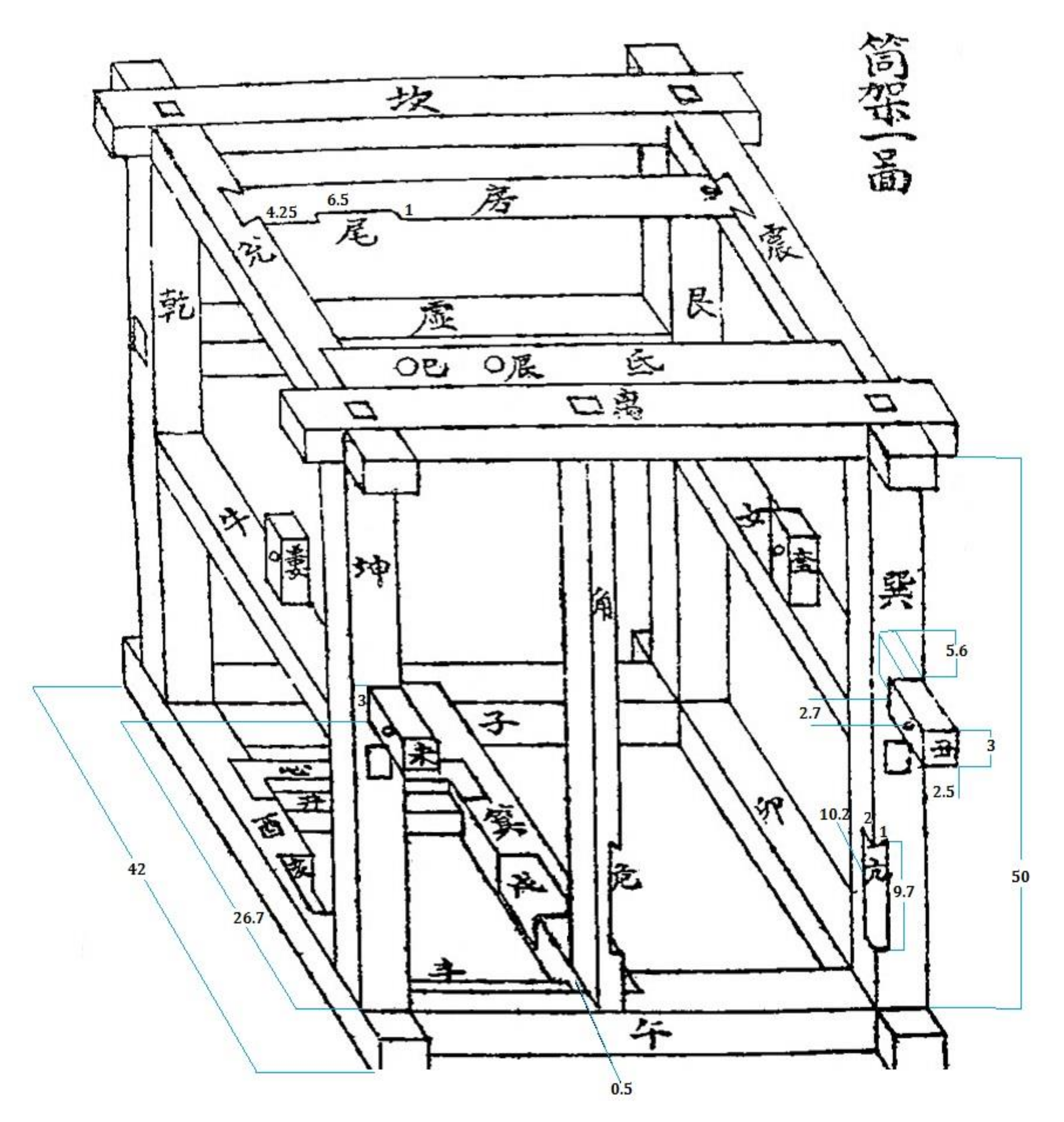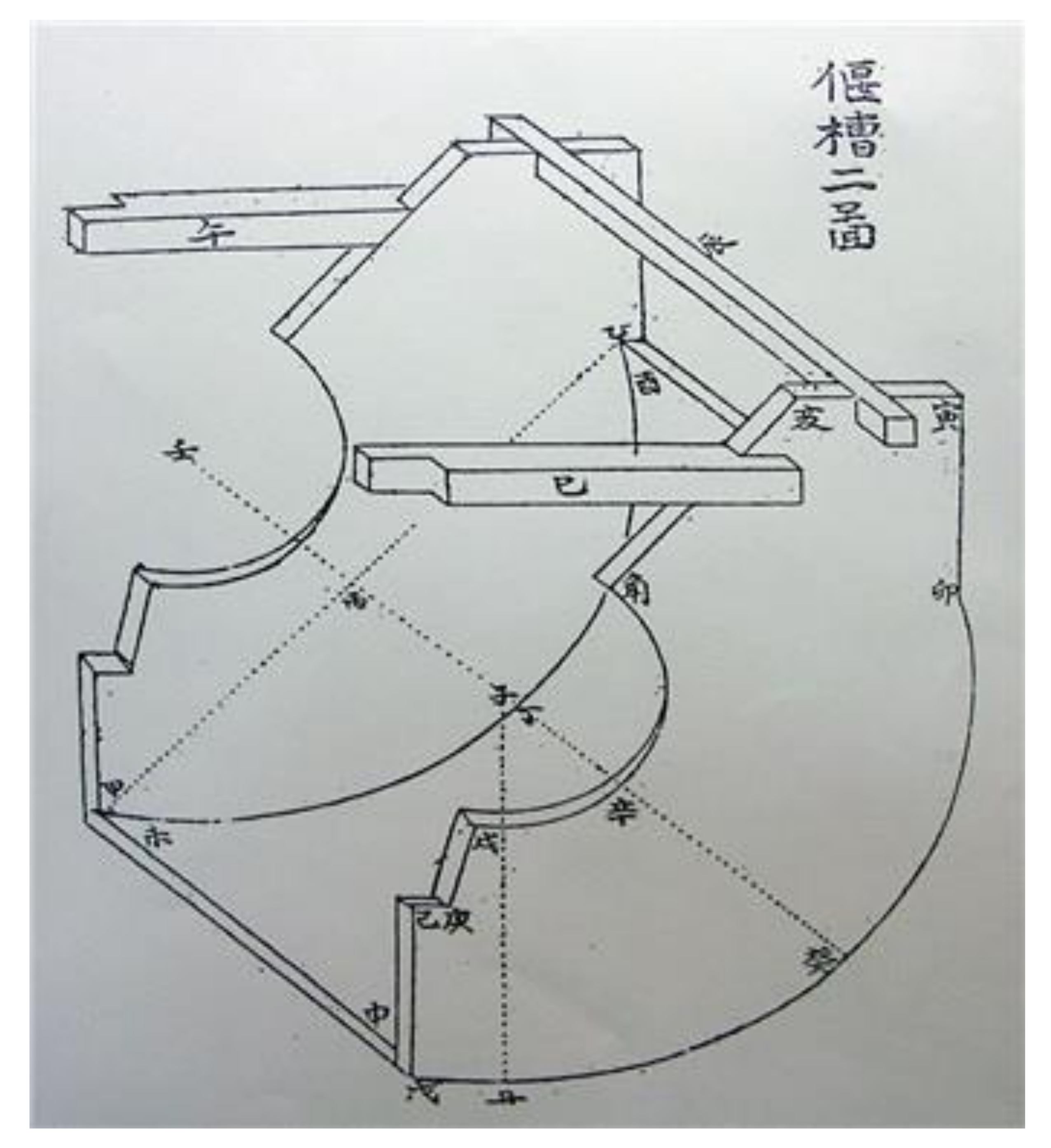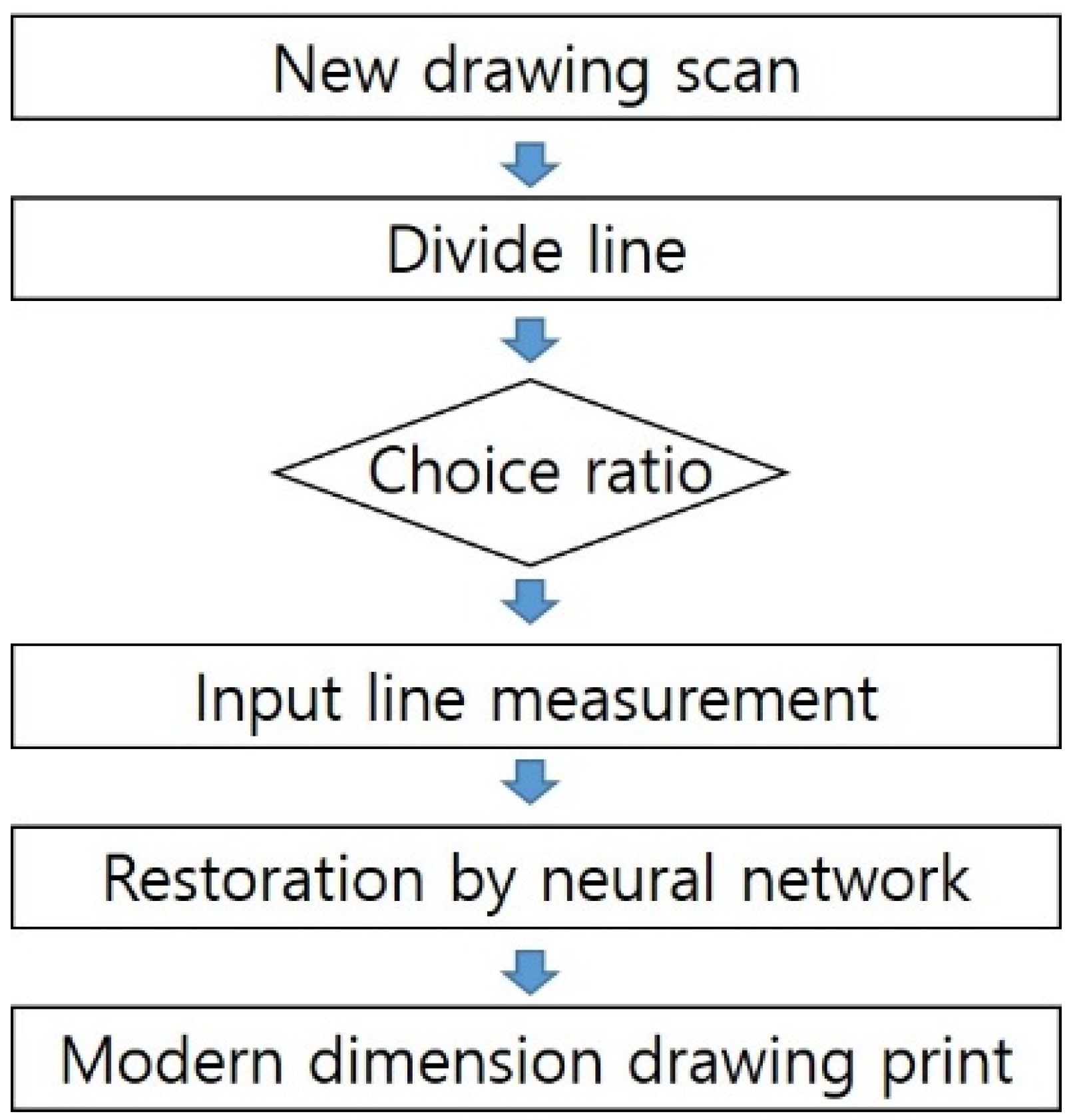Restoration of Dimensions for Ancient Drawing Recognition
Abstract
:1. Introduction
2. Jaseungcha Dohae
3. Measurement and Analysis of Jaseungcha Dohae
- -
- Collection of drawings describing proportional formulae;
- -
- Copying of classical drawings to the same size;
- -
- Measurement of the length of each line in the drawing;
- -
- Storage of neural network learning data for each line segment;
- -
- Implementation of machine learning through the average value of each line.
3.1. Scale Analysis of Tonga in Jaseungcha Dohae
3.2. Scale Analysis of Tonga in Jaseungcha Dohae
4. Conclusions
Author Contributions
Funding
Conflicts of Interest
References
- Ejiri, M.; Kakumoto, S.; Miyatake, T.; Shimada, S.; Iwamura, K. Automatic recognition of engineering drawings and maps. In Image Analysis Applications; CRC Press: Boca Raton, FL, USA, 2020; pp. 73–126. [Google Scholar]
- Nolazco-Flores, J.A.; Faundez-Zanuy, M.; Velazquez-Flores, O.A.; Cordasco, G.; Esposito, A. Emotional State Recognition Performance Improvement on a Handwriting and Drawing Task. IEEE Access 2021, 9, 28496–28504. [Google Scholar] [CrossRef]
- Jen, J.A.; Diah, N.M.; Ibrahim, Z. Drawing and Recognising Simple Shapes with Real-Time Feedback Using Pattern Recognition. In Proceedings of the Computational Science and Technology: 7th ICCST 2020, Pattaya, Thailand, 29–30 August 2020; Volume 724, p. 81. [Google Scholar]
- Bainbridge, W.A.; Pounder, Z.; Eardley, A.F.; Baker, C.I. Quantifying Aphantasia through drawing: Those without visual imagery show deficits in object but not spatial memory. Cortex 2020, 135, 159–172. [Google Scholar] [CrossRef] [PubMed]
- Yao, C.; Zheng, X.; Wang, Z.; Hao, Y.; Li, X.; Hu, Y.; Ying, F. Papimation: A Symbol System for Children to Animate Their Drawing. In International Conference on Human-Computer Interaction; Springer: Cham, Switzerland, 2021. [Google Scholar]
- Panahi, M.; Sadhasivam, N.; Pourghasemi, H.R.; Rezaie, F.; Lee, S. Spatial prediction of groundwater potential mapping based on convolutional neural network (CNN) and support vector regression (SVR). J. Hydrol. 2020, 588, 125033. [Google Scholar] [CrossRef]
- Rahman, T.; Chowdhury, M.E.H.; Khandakar, A.; Islam, K.R.; Mahbub, Z.B.; Kadir, M.A.; Kashem, S. Transfer learning with deep convolutional neural network (CNN) for pneumonia detection using chest X-ray. Appl. Sci. 2020, 10, 3233. [Google Scholar] [CrossRef]
- Mzoughi, H.; Njeh, I.; Wali, A.; Slima, M.B.; BenHamida, A.; Mhiri, C.; Mahfoudhe, K.B. Deep multi-scale 3D convolutional neural network (CNN) for MRI gliomas brain tumor classification. J. Digit. Imaging 2020, 33, 903–915. [Google Scholar] [CrossRef] [PubMed]
- Nguyen, T.P.; Choi, S.; Park, S.-J.; Yoon, J. Inspecting method for defective casting products with convolutional neural network (CNN). Int. J. Precis. Eng. Manuf. -Green Technol. 2020, 8, 583–594. [Google Scholar] [CrossRef]
- Liang, B.; Tian, Y.; Chen, X.; Yan, H.; Yan, L.; Zhang, T.; Zhou, Z.; Wang, L.; Dai, J. Prediction of radiation pneumonitis with dose distribution: A convolutional neural network (CNN) based model. Front. Oncol. 2020, 9, 1500. [Google Scholar] [CrossRef] [PubMed] [Green Version]
- Rustam, Z.; Hartini, S.; Pratama, R.Y.; Yunus, R.E.; Hidayat, R. Analysis of architecture combining convolutional neural network (CNN) and kernel K-means clustering for lung cancer diagnosis. Int. J. Adv. Sci. Eng. Inf. Technol. 2020, 10, 1200–1206. [Google Scholar] [CrossRef]
- Kim, J.H.; Kang, Y.S.; Ko, H.K. A study on historical and cultural viewpoints of traditional measuring units conversion. Korean J. Med. Hist 2010, 23, 15–22. [Google Scholar]
- Ha, W.H. A study on the causes of weights and measures disorder in the late Joseon Dynasty. J. Assoc. Korean Hist. Stud. 1987, 59, 105–136. [Google Scholar]
- Lee, G.C.; Jeon, B.H. The development of the Korean modern system of weights and measures during the modernization period. Arch. Res. 2009, 25, 227–236. [Google Scholar]
- Rim, K.-C. Study of Yeongjocheok and Industry-Academic Calculation Methods Using Scale and Circumference of Jaseungcha Dohae. J. Chosun Nat. Sci. 2020, 13, 63–68. [Google Scholar]
- Gyllenbok, J.; Gyllenbok, J. Goob. In Encyclopaedia of Historical Metrology, Weights, and Measures; Birkhäuser: Cham, Switzerland, 2018. [Google Scholar]



| Location of the Parts | Cheok | Drawing | 15X | Converted Cheok | ||||
|---|---|---|---|---|---|---|---|---|
| Base | East | Length | Upper | Left | 4.2 | 85.78 | 1286.7 | 306.36 |
| Right | 4.2 | 86.61 | 1299.15 | 309.32 | ||||
| Lower | 4.2 | 86.88 | 1303.2 | 310.29 | ||||
| Circumference | Upper | Width | 0.4 | 7.68 | 115.2 | 288 | ||
| Length | 0.4 | 6.33 | 94.95 | 237.38 | ||||
| Lower | Width | 0.4 | 7.93 | 118.95 | 297.38 | |||
| Length | 0.4 | 8.58 | 128.7 | 321.75 | ||||
| West | Length | Upper | Left | 4.2 | 86.10 | 1291.5 | 307.5 | |
| Right | 4.2 | 86.61 | 1299.15 | 309.32 | ||||
| Lower | 4.2 | 86.28 | 1294.2 | 308.14 | ||||
| Circumference | Upper | Width | 0.4 | 8.41 | 126.15 | 315.37 | ||
| Length | 0.4 | 5.76 | 86.4 | 216 | ||||
| Lower | Width | 0.4 | 8.14 | 122.1 | 305.25 | |||
| Length | 0.4 | 7.96 | 119.4 | 298.5 | ||||
| North | Length | Upper | Upper | 4.2 | 103.99 | 1559.85 | 371.39 | |
| Lower | 4.2 | 104.53 | 1567.95 | 373.32 | ||||
| Location of the Parts | Cheok | Drawing | 15X | Converted Cheok | |||
|---|---|---|---|---|---|---|---|
| Column | Length | Front | 5.7 | 101.97 | 1529.55 | 305.91 | |
| Back | 5.7 | 101.97 | 1529.55 | 305.91 | |||
| Circumference | Front | 0.4 | 8.53 | 127.95 | 319.88 | ||
| Back | 0.4 | 8.53 | 127.95 | 319.88 | |||
| Depth | Front | Left | 0.3 | 7.25 | 108.75 | 362.5 | |
| Right | 0.3 | 7.25 | 108.75 | 362.5 | |||
| Back | Left | 0.3 | 5.90 | 88.5 | 295 | ||
| Right | 0.3 | 5.90 | 88.5 | 295 | |||
| Location of the Parts | Cheok | Drawing | 15X | Converted Cheok | |||
|---|---|---|---|---|---|---|---|
| Seungtongga | Connecting Part | Distance | 4.25 | 8.69 | 130.35 | 306.71 | |
| Width | 0.1 | 2.08 | 31.2 | 312 | |||
| Length | 0.65 | 13.21 | 198.15 | 304.85 | |||
| Latch | Inner side | Left | 0.4 | 8.05 | 120.75 | 301.88 | |
| Right | 0.4 | 8.05 | 120.75 | 301.88 | |||
| Surface | Left | 0.3 | 4.76 | 71.4 | 238 | ||
| Right | 0.3 | 4.83 | 71.4 | 238 | |||
| Depth | Left | 0.15 | 2.89 | 43.35 | 289 | ||
| Right | 0.15 | 2.89 | 43.35 | 289 | |||
| Location of the Parts | Cheok | Drawing | 15X | Converted Cheok | ||
|---|---|---|---|---|---|---|
| Pendulum support | Height | Left | 2.67 | 54.11 | 811.65 | 303.99 |
| Right | 2.67 | 54.11 | 811.65 | 303.99 | ||
| Lower side | Left | 0.25 | 4.88 | 73.2 | 292.8 | |
| Right | 0.25 | 4.88 | 73.2 | 292.8 | ||
| Left and Right side | Left | 0.3 | 6.30 | 94.5 | 315 | |
| Right | 0.3 | 6.30 | 94.5 | 315 | ||
| Location of the Parts | Cheok | Drawing | 15X | Converted Cheok | ||
|---|---|---|---|---|---|---|
| Eonjo support | Height | 0.53 | 10.95 | 164.25 | 309.9 | |
| Depth | Inside | 19.56 | 293.4 | 302.47 | ||
| Outside | 0.97 | 19.56 | 293.4 | 302.47 | ||
| Outer groove | Upper | 0.1 | 2.29 | 34.35 | 343.5 | |
| Lower | 0.1 | 2.29 | 34.35 | 343.5 | ||
| Inner groove | Upper | 0.2 | 3.76 | 56.4 | 282 | |
| Lower | 0.2 | 3.65 | 54.75 | 273.75 | ||
| Location of the Parts | Cheok | Drawing | 10X | Converted Cheok | ||
|---|---|---|---|---|---|---|
| Eonjo | Chord | 3.77 | 114.91 | 1149.1 | 304.8 | |
| Si part | 1.06 | 32.75 | 327.5 | 308.96 | ||
| Base | Thickness | 0.1 | 2.33 | 23.3 | 233 | |
| Width | 2 | 64.54 | 645.4 | 322.7 | ||
| Large side width | 2.2 | 67.73 | 67.73 | 307.86 | ||
| Location of the Parts | Cheok | Drawing | 10X | Converted Cheok | ||
|---|---|---|---|---|---|---|
| Eonjo | Side | Length | 4.8 | 145.74 | 1457.4 | 303.625 |
| Thickness | 0.1 | 2.86 | 28.6 | 286 | ||
| Corner | Radius | 2.3 | 70.98 | 709.8 | 308.61 | |
| Height | 1.5 | 72.94 | 729.4 | 486.26 | ||
| Radius | 0.8 | 24.62 | 246.2 | 307.8 | ||
| Location of the Parts | Cheok | Drawing | 10X | Converted Cheok |
|---|---|---|---|---|
| Dimensions of other parts of Eonjo | 0.47 | 13.4 | 134 | 285.11 |
| 1 | 29.52 | 295.2 | 295.2 | |
| 0.2 | 5.08 | 50.8 | 254 | |
| 1.1 | 33.41 | 334.1 | 303.73 | |
| 0.8 | 24.5 | 245 | 306.25 | |
| 0.16 | 4.74 | 47.4 | 296.25 | |
| 2.06 | 79.11 | 791.1 | 304.27 | |
| 2 | 60.13 | 601.3 | 300.65 | |
| 0.2 | 5.99 | 59.9 | 299.5 |
Publisher’s Note: MDPI stays neutral with regard to jurisdictional claims in published maps and institutional affiliations. |
© 2021 by the authors. Licensee MDPI, Basel, Switzerland. This article is an open access article distributed under the terms and conditions of the Creative Commons Attribution (CC BY) license (https://creativecommons.org/licenses/by/4.0/).
Share and Cite
Rim, K.-c.; Kim, P.-k.; Ko, H.; Bae, K.; Kwon, T.-g. Restoration of Dimensions for Ancient Drawing Recognition. Electronics 2021, 10, 2269. https://doi.org/10.3390/electronics10182269
Rim K-c, Kim P-k, Ko H, Bae K, Kwon T-g. Restoration of Dimensions for Ancient Drawing Recognition. Electronics. 2021; 10(18):2269. https://doi.org/10.3390/electronics10182269
Chicago/Turabian StyleRim, Kwang-cheol, Pan-koo Kim, Hoon Ko, Kitae Bae, and Tae-gyun Kwon. 2021. "Restoration of Dimensions for Ancient Drawing Recognition" Electronics 10, no. 18: 2269. https://doi.org/10.3390/electronics10182269
APA StyleRim, K.-c., Kim, P.-k., Ko, H., Bae, K., & Kwon, T.-g. (2021). Restoration of Dimensions for Ancient Drawing Recognition. Electronics, 10(18), 2269. https://doi.org/10.3390/electronics10182269







